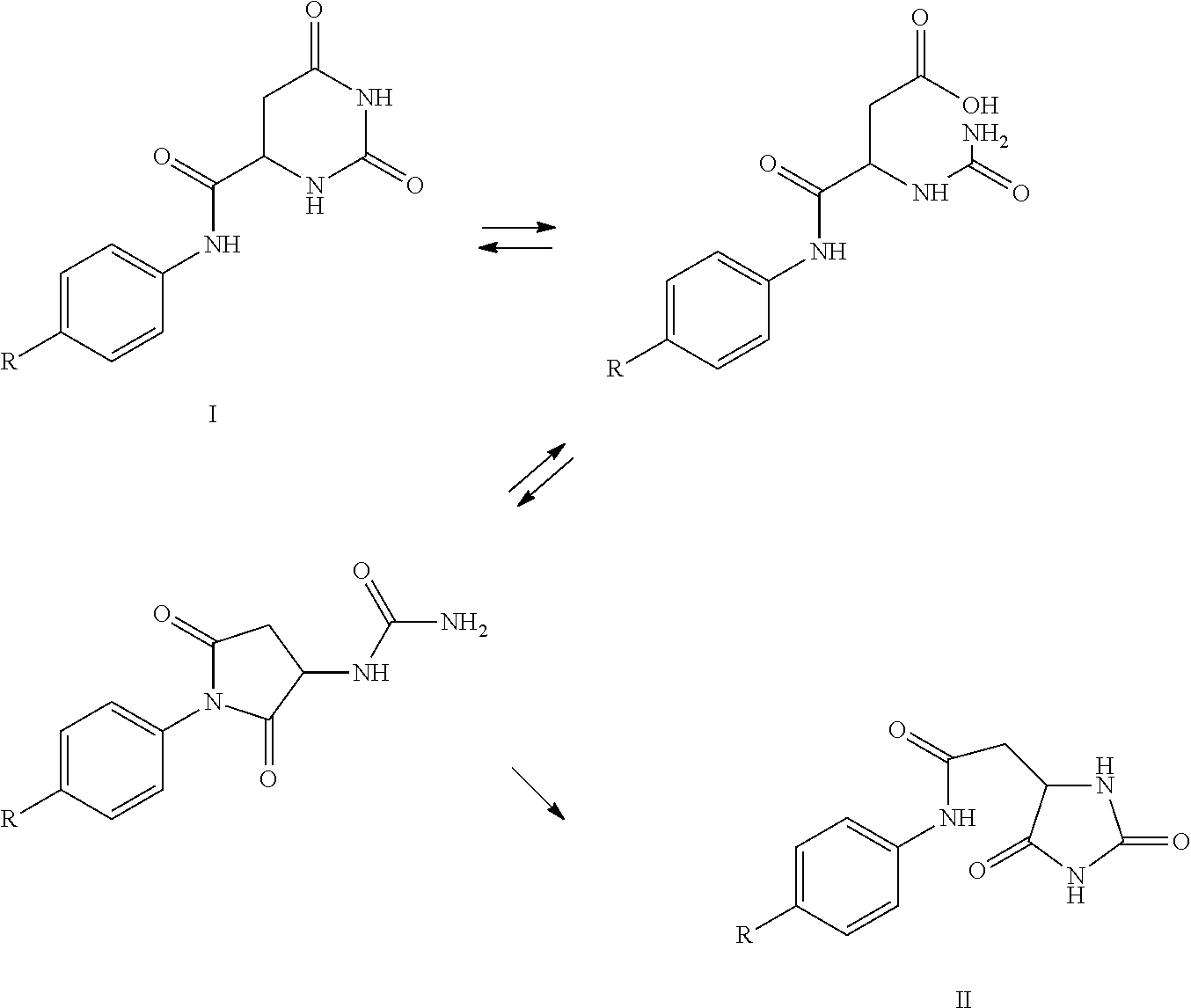Method for the manufacture of degarelix
a technology of decapeptide and degarelix, which is applied in the direction of peptides, drug compositions, peptides/protein ingredients, etc., can solve the problems of substantial loss of product, difficult separation of hydantoin by-products, and inability to tolerate more than 0.3 by weight of by-products
- Summary
- Abstract
- Description
- Claims
- Application Information
AI Technical Summary
Benefits of technology
Problems solved by technology
Method used
Image
Examples
example 1
Hydantoin Formation in the Synthesis of Degarelix
[0059]The rearrangement of the hydroorotic group to a hydantoinacetyl group in the production of degarelix has been seen at two stages and two sets of basic conditions.
[0060]The first rearrangement appeared during basic extractions of the segment Z-Ser(tBu)-4Aph(Hor)-D-4Aph(tBu-Cbm)-Leu-ILys(Boc)-Pro-D-Ala-NH2. The pH was adjusted to 9.1 in the organic / aqueous two-phase system using conc. NaOH solution, resulting in the formation of 4.5% by weight of the hydantoin analogue. The mechanism appeared to comprise two steps: (a) hydrolysis of the 6-membered hydroorotic moiety under basic conditions followed by ring closure to the 5-membered hydantoin analogue under acidic conditions.
[0061]The second rearrangement was observed during evaporation of the segment Z-Ser(tBu)-4Aph(Hor)-D-4Aph(tBu-Cbm)-Leu-OH.DCHA. After the preceding extractions, Z-Ser(tBu)-4Aph(Hor)-D-4Aph(tBu-Cbm)-Leu-OH was dissolved in a mixture of ethyl acetate and 2-butanol...
example 2
Stability of Degarelix in DBU / DMF and Piperidine / DMF
[0063]The stability of degarelix was tested under conditions corresponding to those used for removal of the Fmoc-group during SPPS. The hydroorotic group in the side chain of 4Aph(Hor), amino acid residue no. 5 in the sequence of degarelix, is known to be sensitive to base and rearrange to a hydantoinacetyl group. All SPPS procedures known to the inventors had been based on Boc-chemistry.
[0064]Samples of degarelix were dissolved in 20% piperidine / DMF; 2% DBU in DMF, and 2% DBU+5% water in DMF; respectively. The samples were analysed by HPLC after 20 h and the amount of the hydantoin analogue determined.
[0065]2% DBU / DMF resulted in the formation of 1.8% hydantoin. If 5% water was present, too (simulating wet DMF), the amount was increased to 7%. Surprisingly, the use of 20% piperidine in DMF did not result in any formation of the hydantoin analogue, indicating that this mixture might be useful for Fmoc-based SPPS of Degarelix.
example 3
Synthesis and Purification of Degarelix Using Fmo- / Rink Amide AM Resin
[0066]Step 1. Fmoc-Rink amide AM resin (64 g; substitution 0.67 mmol / g) was placed in a reactor and washed with 1.9 L DMF. To the swollen resin 250 ml of 20% piperidine in DMF is added and stirred for 20 min. The reactor is emptied through the filter in the bottom by applying vacuum to the reactor and a second treatment with 250 ml 20% piperidine in DMF is performed for 20 min. The reactor is once again emptied by applying vacuum to it followed by a wash of the peptide resin using 2 L of DMF. The reactor is then emptied by applying vacuum. The peptide resin is now ready for step 2.
[0067]Step 2. A solution of 27.0 g Fmoc-D-Ala-OH (2 eq.), 14.3 g HOBt and 13.2 ml DIC is dissolved in 250 ml of DMF and allowed to activate for 15 min, after which it is poured into the reactor containing the peptide resin. After 1 h of reaction time, 2.2 ml of NMM is added to the solution and the reaction is allowed to proceed for anoth...
PUM
| Property | Measurement | Unit |
|---|---|---|
| reaction time | aaaaa | aaaaa |
| flow rate | aaaaa | aaaaa |
| time | aaaaa | aaaaa |
Abstract
Description
Claims
Application Information
 Login to View More
Login to View More - R&D
- Intellectual Property
- Life Sciences
- Materials
- Tech Scout
- Unparalleled Data Quality
- Higher Quality Content
- 60% Fewer Hallucinations
Browse by: Latest US Patents, China's latest patents, Technical Efficacy Thesaurus, Application Domain, Technology Topic, Popular Technical Reports.
© 2025 PatSnap. All rights reserved.Legal|Privacy policy|Modern Slavery Act Transparency Statement|Sitemap|About US| Contact US: help@patsnap.com

